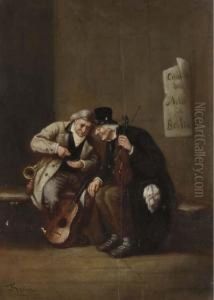Joseph Von Keller Paintings
Joseph von Keller was a German painter and art professor, born on September 23, 1811, in Gaisburg, which is now part of Stuttgart, Germany. He was known for his religious paintings, history paintings, and portraits, exemplifying the style of 19th-century academic art. Keller studied at the Royal Academy of Fine Arts in Munich, a center for art and culture in the 19th century. His education there would have provided him with a solid foundation in the techniques and traditions of fine art.
After completing his studies, Keller traveled to Rome, which was a common practice for artists of his time. The city was considered the epicenter of art and antiquity, and Keller, like many of his contemporaries, sought inspiration from the Renaissance masters and the rich tapestry of Roman history and archaeology. His time in Rome had a significant influence on his artistic style and thematic choices.
Keller returned to Germany and became a professor at the Stuttgart Art School, where he influenced a generation of young artists. As a teacher, Keller was known for emphasizing the importance of drawing and the study of historical art, encouraging his students to develop their skills in representing the human form and to engage with traditional themes and narratives.
Throughout his career, Keller received various commissions for religious works, which were very much in demand at the time, particularly in Southern Germany. His paintings often featured dramatic lighting and a fine attention to detail, which were hallmarks of the academic style that sought to emulate the precision and skill of Renaissance masters.
Joseph von Keller's contributions to German art were recognized during his lifetime, and his works were collected and displayed in various institutions. He passed away on August 21, 1873, in Stuttgart. Today, Keller's legacy is preserved in the art collections of Germany, and his influence continues through the students he taught and the impact he had on the academic art tradition in the region.
